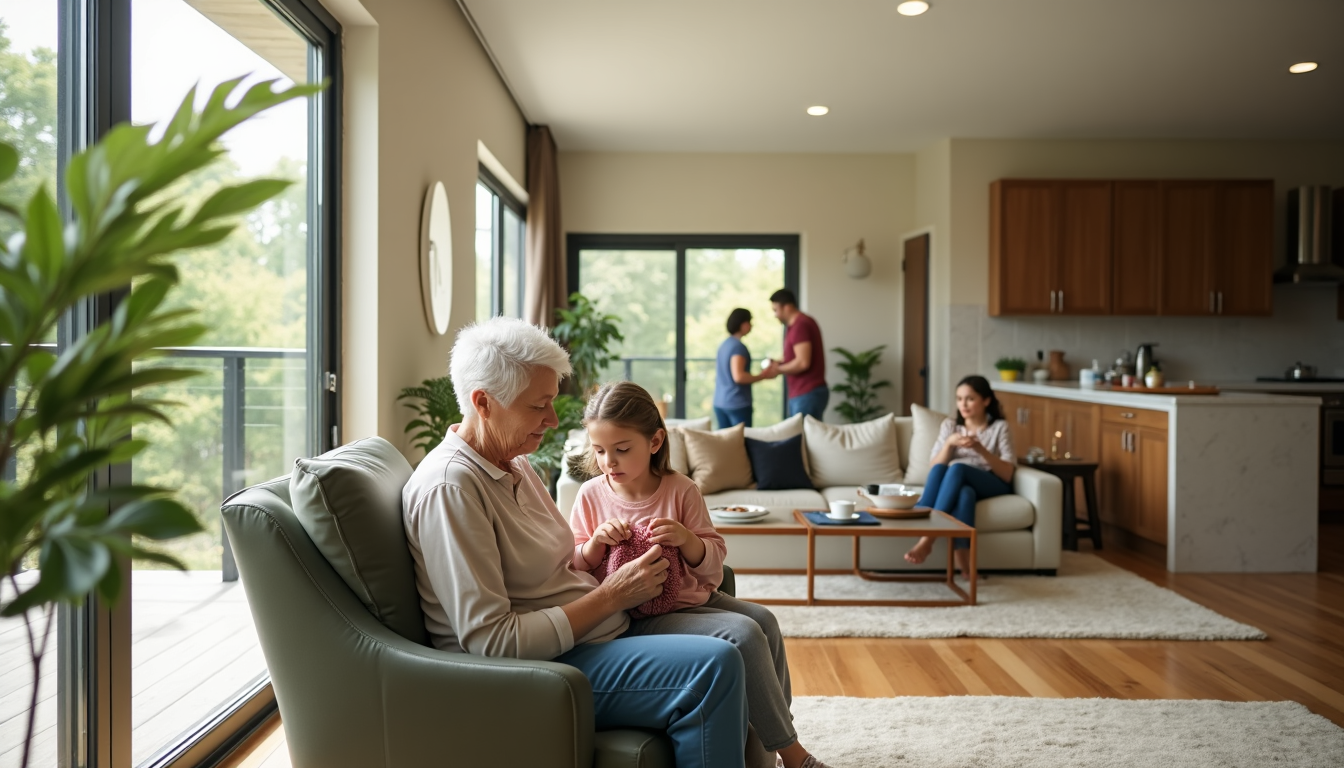The number of adults living in multigenerational households has nearly quadrupled in the last decade. One in four Americans now embrace this living arrangement, which signals a fundamental change in how we view housing and community living.
This trend arrives at a significant moment in U.S. history. By 2034, older Americans will exceed the number of children under 18, while 27% of adults aged 60 and older live alone. Intergenerational living communities provide compelling solutions to these demographic challenges. Studies reveal these arrangements strengthen family bonds and improve mental well-being. They also lower mortality rates among older adults.
Intergenerational living communities shape tomorrow’s housing landscape. This piece explores successful models worldwide and their economic advantages. We analyze design elements that make these communities thrive. The insights will help you understand how to realize the full potential of intergenerational living, whether you plan your family’s future or seek alternative housing options.
The Evolution of Housing: From Nuclear to Intergenerational Living
Americans used to live together with multiple generations under one roof – it was just the way things were. Most elderly Americans lived with their adult children throughout the 1800s. This living arrangement went through a dramatic change as society and the economy evolved.
Traditional housing models and their limitations
The years after World War II saw the fewest multigenerational homes in American history, creating standards that still shape how we design houses today. People valued independence more, which meant young adults moved out earlier and older parents lived on their own. By 1980, the numbers hit an all-time low – only 12% of Americans lived in multigenerational homes.
Traditional homes built for nuclear families come with several drawbacks:
- They cost too much for many families
- They don’t adapt well when family needs change
- Older family members often end up isolated
- Space and resources aren’t used well
These problems become more obvious as housing affordability gets worse across the country. Traditional homes also lack the right spaces that multiple generations need to live together comfortably.
The rise of multigenerational households in history
Multigenerational living in America started with farming families. Living together on farms made perfect sense – children helped with the work, and parents passed down their land to the next generation. This created a natural way to age, where elderly parents stayed on the farm and their children looked after them.
Social Security changed everything when it arrived in 1935. Monthly payments meant older parents could afford their own homes. So house designs started focusing on smaller, nuclear family units instead of extended families.
Current housing crisis and demographic shifts
Multigenerational living has made an impressive comeback since 1980. Today, about 59.7 million Americans (18% of the population) share homes with multiple generations – almost four times more than in 1971. This trend picked up speed during the Great Recession of 2007-2009 and hasn’t slowed down.
Several reasons explain this big change:
- Housing costs keep rising faster than incomes
- Demographics are changing, with more older people
- America’s population is becoming more diverse
People under 40 made up almost half (49%) of the increase in multigenerational households, even though they only represented 17% of overall population growth. This living arrangement is growing popular across all groups. Non-Hispanic White Americans contributed to 28% of the growth in multigenerational households between 2000-2021.
These changes show that intergenerational living communities aren’t just a temporary fix for tough economic times. They represent a fundamental change in how Americans think about home and family.
Designing Spaces for All Ages: Architecture and Technology
Living spaces that work for people of all ages need smart design and the right technology. Designers and architects worldwide are coming up with innovative ways to make intergenerational communities work better for everyone.
Smart home features that benefit multiple generations
Smart technology plays a vital role in making multigenerational homes successful. A surprising fact shows older Americans love their smart home technology. About 60% of adults over 50 say they’re “very satisfied” with smart appliances. This number drops to just 27% for those aged 25-29. These systems let each family member set their own priorities for temperature and lighting that change automatically throughout the day.
Smart homes do more than just add convenience – they help save energy too. Families from different age groups say eco-friendly features are their top benefit. This helps households cut costs while managing the needs of multiple generations.
Accessible design principles for aging in place
Universal design is the foundation of good intergenerational living. It creates spaces everyone can use without changes. Key features include:
- Zero-step entryways for wheelchair access
- Doorways and hallways at least 36 inches wide
- Living space on one floor
- Switches 42-48 inches above floor level and outlets 18-24 inches high
- Doors and faucets with lever-style handles
These elements help homes stay useful as residents’ needs evolve. Building these features during original construction costs much less than adding them later.
Shared and private spaces: striking the right balance
The best intergenerational communities blend common areas with private spaces perfectly. Smart floor plans create separate living zones while keeping family gathering spots. Many homes now use soundproofing between areas and separate entrances to give everyone more privacy.
Technology that bridges the generation gap
Technology brings different generations closer together. Programs that connect tech-savvy teenagers with older adults have become a soaring win. Seniors learn to use digital devices while building meaningful relationships with young people. New platforms like Nesterly match older homeowners with younger renters who need affordable housing. This solves both housing costs and loneliness issues at once.
Economic Benefits of Intergenerational Communities
Living in intergenerational communities doesn’t just help people connect socially – it brings major money-saving benefits to residents of every age. These communities create both immediate and long-term financial stability, making them an attractive housing choice in today’s economic climate.
Cost-sharing models that make housing affordable
Money worries drive 40% of Americans to choose multigenerational living arrangements. This setup completely changes how affordable housing can be through shared costs:
- Housing costs (mortgage/rent, property taxes, maintenance)
- Utilities and household services
- Food and groceries (bought in bulk)
- Shared amenities and facilities
These communities work well financially because senior residents provide steady, reliable income while younger tenants fill vacancies with shorter leases. This creates steady occupancy year-round and lets operators adjust rents as markets change, keeping finances stable even when markets get shaky.
Long-term financial advantages for families
The money-saving benefits go well beyond monthly cost cuts. Census data shows people in multigenerational homes have lower poverty rates (10%) compared to other living situations (12%). These benefits help vulnerable groups even more – poverty from unemployment drops from 19% to 11% in multigenerational homes.
Families can buy homes in better neighborhoods by pooling their resources. Multiple people pitching in for mortgages and daily expenses boost the family’s buying power substantially.
Reduced healthcare costs through mutual support
Healthcare savings stand out as a huge benefit of intergenerational support. Research from Asian countries, where multigenerational living is common, shows emotional support from children helps cut down major health costs for middle-aged and elderly family members.
Family care makes a big difference in medical spending – people getting care from family members spend less on non-hospital medical costs. Research shows that using services like peer support and home help could save up to $483 million yearly.
Children’s financial support helps improve their elderly parents’ mental health, which can lower mental healthcare costs. Multigenerational homes also share healthcare resources – from medical equipment to combined healthcare funds – so everyone gets the care they need.
Successful Intergenerational Housing Models Worldwide
Around the world, shared living spaces create strong communities and help solve housing problems. These groundbreaking projects show other communities how to build successful multigenerational neighborhoods.
European cohousing communities: lessons learned
Denmark leads the way in cohousing development since the 1970s. Today, about 1% of Denmark’s population (50,000 people) lives in cohousing communities. The Netherlands has created its own unique model. They organize large communities into clusters of 5-10 units. Each cluster has its own common spaces while sharing bigger community areas. Germany has become a world hub for cohousing, with over 150 projects just in Berlin’s region.
Spain’s Municipal Project for Intergenerational Housing built 244 affordable units in central Alicante. These communities let older residents stay independent as they age. The design of these spaces encourages different generations to interact through careful planning and activities.
Asian family-centered approaches
Asian models of intergenerational living put family values ahead of individual needs. This cultural foundation makes Asian Americans more likely to share homes with multiple generations and help family members financially. On top of that, grandparents often take care of children just like parents do and shape their family’s eating habits.
Housing systems in industrialized East Asian economies shifted toward helping people own homes. People saw this as a way to boost economic growth and build family wealth.
Innovative American intergenerational projects
American multigenerational communities come in many forms, from resident-built cohousing to specialized models for specific groups. Bridge Meadows stands out as a diverse community where older adults, children, and families help and mentor each other. H.O.M.E. in Chicago runs 78 apartments in three affordable buildings where seniors can choose private units or more supportive family-style living.
One Flushing in Queens, NY shows how mixed-age apartment buildings can work with social services and community features. These communities create spaces that bring generations together while giving everyone their privacy.
University-linked retirement communities
University-based retirement communities (URCs) are growing fast with over 100 facilities near campuses in 30 states. These communities mix senior care with learning opportunities. Residents can take classes, go to campus events, and even teach or mentor students.
Lasell Village near Boston asks residents to spend 450 hours each year learning through classes, research projects, and cultural activities. The Varcity at Purdue University will welcome alumni back to campus with 230 rental units on 14 acres. These communities create spaces where knowledge and experience flow naturally between generations.
Conclusion
Intergenerational living communities solve modern housing challenges and provide great social and economic benefits. Studies show these communities help reduce isolation among older adults. They create opportunities to share costs and build stronger family connections between generations.
Projects in Denmark, Netherlands, and America showcase how smart design and technology help different generations live together harmoniously. These communities become even more valuable as demographics change in the U.S. Soon, older Americans will outnumber children under 18 for the first time in the nation’s history.
The economic benefits make this housing model worth thinking over. Families seeking financial stability find shared expenses, lower healthcare costs, and better purchasing power very attractive. On top of that, technology helps bridge generation gaps and improves everyone’s daily life.
These communities will become more common as housing costs continue to rise and populations age. They tackle multiple challenges at once – from making homes affordable to preventing social isolation. This makes them an eco-friendly housing solution for years to come. We shouldn’t see this trend as just a response to economic pressure. Instead, it marks a return to traditional living arrangements that help every generation thrive.
FAQs
Q1. What are the main advantages of intergenerational living communities? Intergenerational living communities offer numerous benefits, including cost-sharing opportunities, reduced isolation for older adults, strengthened family bonds, and potential healthcare savings through mutual support. They also provide a sustainable solution to housing challenges while fostering social connections across generations.
Q2. How do intergenerational communities address housing affordability? These communities make housing more affordable through shared expenses such as rent/mortgage, utilities, groceries, and household services. By pooling resources, families can often access better housing in desirable neighborhoods that might otherwise be out of reach. This model also allows for balanced revenue streams, benefiting both long-term senior residents and younger tenants.
Q3. What design considerations are important for successful intergenerational living spaces? Successful intergenerational living spaces incorporate universal design principles, such as no-step entryways, wider doorways, and single-floor living arrangements. They also balance shared and private areas, utilize smart home technologies, and implement features that allow residents to age in place comfortably.
Q4. How does technology play a role in intergenerational communities? Technology serves as a connector between generations in these communities. Smart home features benefit residents of all ages, improving energy efficiency and customization. Additionally, programs pairing tech-savvy younger residents with older adults help bridge the digital divide while fostering meaningful relationships.
Q5. Are there successful examples of intergenerational housing models worldwide? Yes, there are numerous successful models globally. European countries like Denmark and the Netherlands have pioneered cohousing communities. In the US, projects like Bridge Meadows and H.O.M.E. in Chicago demonstrate diverse approaches to intergenerational living. Additionally, university-linked retirement communities are growing in popularity, combining senior care with educational opportunities.




